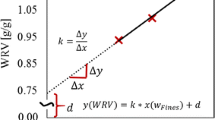Abstract
The objective of the study was to determine the swelling of different types of mechanical pulp fines. The physical and chemical characteristics of the fines were also examined. It was found that the degree of swelling correlates with the proportion of fibrillar material, that is fibrillar content of the fines. The fines with the lowest fibrillar content had a swelling comparable to mechanical pulp fibres (0.69 g/g), whereas the fines with a high fibrillar content had a swelling comparable to never‐dried kraft pulp fibres (1.41 g/g). Hemicellulose content and charge could not explain the differences in swelling of different types of the mechanical pulp fines. While the lignin content appears to be an important factor in the degree of swelling of mechanical pulp fines, the results suggest that structural differences between the particles are also important. The ‘bulk elastic modulus’ was determined by measuring the change in swelling for a known change in osmotic pressure. All the mechanical pulp fines had a high bulk elastic modulus compared to kraft fines. However, fibrillar fines had a lower bulk elastic modulus than flake‐like fines. Mechanical pulp fines, both fibrillar and flake‐like varieties, did not hornify appreciably. The swelling of both the fines and the fibre fractions increased slightly with the specific energy consumption in the refining.
Similar content being viewed by others
References
Eriksson, I., Haglind, I., Lidbrandt, O. and Salmen, L. (1991) Fiber swelling favoured by lignin softening. Wood Sci. Technol. 25, 135–144.
Janson, J. (1970) Calculation of the polysaccharide composition of wood and pulp. Pap. Timb. 52, 323–329.
Laine, J., Buchert, J., Viikari, L. and Stenius, P. (1996) Characterization of unbleached kraft pulps by enzymatic treatment, potentiometric titration and polyelectrolyte adsorption. Holzforschung 50, 208–214.
Laivins, G. V. and Scallan, A. M. (1996) The influence of drying and beating on the swelling of fines. J. Pulp Pap. Sci. 22, J178–J184.
Laivins, G. V. and Scallan, A. M. (1993) The mechanism of hornification of wood pulps: Products of papermaking. In Transactions of the 10th Fundamental Research Symposium, Oxford (C. F. Baker, ed.). pp. 1235–1260.
Lindström, T. and Carlsson, G. (1982) The effect of chemical environment on fiber swelling. Svensk Papperstidn. 85, R14–R20.
Lindström, T. (1992) Chemical factors affecting the behavior of fibres during papermaking. Nord. Pulp Pap. Res. J. 7, 181–192.
Luukko, K., Kemppainen-Kajola, P. and Paulapuro, H. (1997) Characterization of mechanical pulp fines by image analysis. Appita J. 50, 387–392.
Luukko, K. and Paulapuro, H. (1998) Development of fines quality in the TMP process. Preprints of the CPPA 84th Annual Meeting, January 26–30, 1998, Montreal, Canada. pp. B23–B28. (To be published in J. Pulp Pap. Sci.).
Luukko, K. and Paulapuro, H. (1999) Mechanical pulp fines: Effect of particle size and shape. Tappi J. 82, 96–101.
Maloney, T. C. and Paulapuro, H. The formation of pores in the cell wall. (Unpublished).
Sjöström, E., Haglund, P. and Janson, J. (1966) Quantitative determination of carbohydrates in cellulosic materials by gas-liquid chromatography. Svensk Papperstidn. 69, 381–385.
Stone, J. E. and Scallan, A. M. (1968) A structural model for the cell wall of water swollen wood pulp fibers based on their accessibility to macromolecules. Cellulose Chem. Tech. 2, 343–358.
Scallan, A. M. and Grignon, J. (1979) The effect of cations on pulp and paper properties. Svensk Papperstidn. 82, 40–47.
Scallan, A. M. and Tigerström, A. C. (1992) Swelling and elasticity of the cell walls of pulp fibres. J. Pulp Pap. Sci. 18, J188–J193.
Swerin, A., Ödberg, L. and Lindström, T. (1990) Deswelling of hardwood kraft fibers by cationic polymers. Nord. Pulp Pap. Res. J. 5, 188–196.
Wågberg, L. and Annergren, G. (1997) Physico-chemical characterisation of papermaking fibres. In Transactions of the 11th Fundamental Research Symposium Vol. 1. Cambridge: Pira International. pp 1–82.
Author information
Authors and Affiliations
Rights and permissions
About this article
Cite this article
Luukko, K., Maloney, T.C. Swelling of mechanical pulp fines. Cellulose 6, 123–136 (1999). https://doi.org/10.1023/A:1009256307149
Issue Date:
DOI: https://doi.org/10.1023/A:1009256307149




